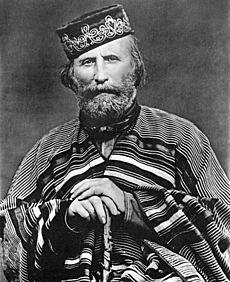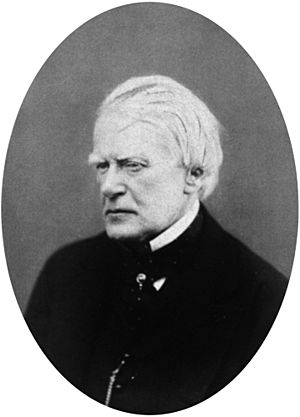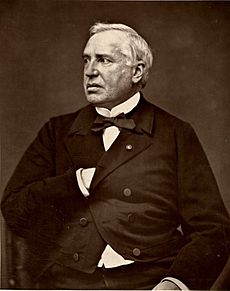Richard Partridge facts for kids
Richard Partridge (born January 19, 1805, in Ross-on-Wye, England – died March 25, 1873, in London) was an important British surgeon. He became the leader of major medical groups like the Royal College of Surgeons and the Royal Medical and Chirurgical Society. He is remembered for helping catch a dangerous gang called the London Burkers. He is also known for a famous case where he missed a bullet in the leg of Giuseppe Garibaldi, a famous Italian hero.
Richard was the tenth child in his family. He was the youngest son of twelve children. His father, Samuel Partridge, was a merchant from Scotland. Richard's oldest brother, John Partridge, became a well-known painter.
Contents
Becoming a Surgeon
Richard Partridge started his medical training in 1821. He worked with his uncle, W.H. Partridge, in Birmingham. There, he also assisted a famous surgeon named Joseph Hodgson. Hodgson later became a president of the Royal College of Surgeons.
In 1827, Richard moved to London to study at St Bartholomew's Hospital. He learned from famous doctors like John Abernethy. In the same year, he became a member of the Royal College of Surgeons. He also became a licensed apothecary, which meant he could prepare and sell medicines.
Early Jobs and Teaching
Partridge held several important jobs early in his career. He taught anatomy at the Windmill Street School of Medicine. From 1831 to 1836, he was a demonstrator of anatomy at King's College. He became a professor there in 1836, teaching about the human body and surgery.
He also worked as a surgeon at Charing Cross Hospital from 1836 to 1840. In 1840, he became a surgeon at the new King's College Hospital. He worked there until 1870. From 1853, he also taught anatomy at the Royal Academy, a famous art school.
Leading Medical Groups
Richard Partridge became a Fellow of the Royal Society in 1837. This is a very high honor for scientists. He was also one of the first 300 fellows of the Royal College of Surgeons. He served as vice-president in 1865 and then as president in 1866. He also led the Royal Medical and Chirurgical Society. He was its vice-president from 1847 to 1848 and president from 1863 to 1864.
The London Burkers Case
Partridge played a key role in catching a dangerous group of criminals. This gang was known as the London Burkers. They were named after earlier criminals in Scotland, Burke and Hare. These gangs killed people to sell their bodies for medical study.
How the Gang Was Caught
On November 5, 1831, Partridge had just started working at King's College. Four members of the gang tried to sell him a body. They called it the 'Italian Boy' and asked for nine guineas. Partridge and the dissecting-room porter, William Hill, were suspicious. The body looked too fresh, as if it had never been buried. It also had a cut on its forehead.
Partridge was very clever. He pretended he didn't have enough change for a large bill. This gave him time to secretly alert his boss, Herbert Mayo. All four gang members were arrested while they waited for their payment.
The Trial and Aftermath
Partridge was present during the autopsy of the boy's body. He later gave evidence at the murder trial. He said the boy's injuries looked like he had been hit hard on the back of the neck. Witnesses identified the victim as Carlo Ferriere, an Italian street performer.
The crime shocked the public. About 30,000 people came to watch the hangings of some of the gang members. A play called The Italian Boy was even performed. Partridge's involvement made him well-known at a young age. The case deeply affected him, and he often shared the story in his lectures.
The public's anger about the case led to a new law. This was the Anatomy Act of 1832. This law allowed medical schools to use bodies of people who died poor and whose relatives did not claim them. This stopped the illegal trade of body snatching.
The Garibaldi Consultation

In September 1862, Richard Partridge was chosen for a special trip to Italy. He went to treat Giuseppe Garibaldi, a famous Italian general and hero. Garibaldi had been shot in his right ankle during a march.
The Challenge of the Bullet
Before X-rays were invented, finding a bullet inside a body was very hard. The doctors treating Garibaldi disagreed about whether the bullet was still in his ankle. After two weeks, his ankle got worse. Some doctors thought they might need to amputate his leg. People in England worried about the popular Italian hero. A public collection raised money to send a British surgeon to give a second opinion.
It's not clear why Partridge was chosen. He was a respected surgeon, but he wasn't as famous as some others. He also didn't have much experience with gunshot wounds. Some doctors at the time criticized the mission. They felt it was wrong to consult on a patient without being invited by the other doctors.
Partridge's Diagnosis
Despite the criticism, Partridge was welcomed by Garibaldi's doctors in Varignano. After examining Garibaldi, Partridge believed the bullet was not in the joint. He thought Garibaldi would get better with rest.
Unfortunately, Partridge's prediction was wrong. By the end of October, Garibaldi's leg developed a serious infection called sepsis. It looked like amputation might be necessary.
Nélaton's Solution
Then, a French surgeon named Auguste Nélaton was asked to examine Garibaldi. Nélaton was known for new surgical tools. He used a special probe with a tip made of unglazed porcelain. This probe could be put into the wound and would show an impression if it touched a bullet.
Using this improved probe, an Italian surgeon named Zanetti became sure the bullet was there. On November 23, he successfully removed it. This saved Garibaldi's leg. This case showed how new surgical tools were becoming very important in medicine.
Partridge did re-examine the wound later and agreed with Nélaton. However, his initial mistake damaged his professional reputation. It also caused some tension between British and European surgeons.
Skills and Personal Life
Richard Partridge was known for being very careful with his patients after operations. He was also a skilled artist. He took drawing lessons from his brother, John Partridge. He was a good lecturer and teacher too. He wrote an article about the face for a medical book in 1839. He also wrote and drew for a book on anatomy, but it was never published.
Partridge married Frances Janette Turner. They had several children, including Sir John Bernard Partridge, who became an illustrator and actor. Richard Partridge died in London in 1873. His career never fully recovered from his mistake in Garibaldi's case.



